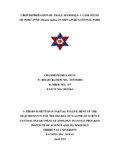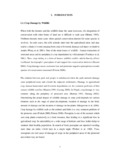Please use this identifier to cite or link to this item:
https://elibrary.tucl.edu.np/handle/123456789/3561| Title: | Crop Depredation by Small Mammals: A Case Study of Porcupine (Hystrix Indica) in Shivapuri National Park |
| Authors: | Kaway, Chandeswori |
| Keywords: | Crop damage;Mammals |
| Issue Date: | 2011 |
| Publisher: | Central Department of Zoology |
| Institute Name: | Central Department of Zoology |
| Level: | Masters |
| Abstract: | This study of crop depredation by porcupine was done from April to October 2009 in Shivapuri National Park and its adjoining VDCs including Sangla, Samundradevi and Sundarijal. The main objective of this study was to explore the damages of crops by porcupine in Shivapuri National Park as well as to investigate the distribution and habitat of the porcupine. Methods of this study included reconnaissance survey, field survey and questionnaire surveys. The study area was divided into three sites to investigate the distribution and habitat of porcupine. Distribution was investigated using indirect evidence such as the presence of quills, foot prints and burrows in three sites of the study area. Distribution of porcupines was significantly different in three sites (χ² =18.51> χ² p=0.05,df=2). The mostly preferred crops of porcupines were maize and potatoes while mustard and paddy were not so preferred food by them. Porcupines were found in a wide range of habitats including rocky hills (34.54%), bushy area (23.64%), steep slope (10.91%) and nearby agricultural lands (14.54%). Although they were found in wide range of habitats, they mostly preferred rocky hills, less slope and undisturbed area with availability of food. The chi- square test showed that they were uniformly found in all types of habitats (χ² =9.36 > χ² p=0.05, df=4). From the questionnaire survey total crop loss by porcupine in the study areas was 7320.37kg. Among the crop loss, rooted crop loss was the highest (60.18%), followed by maize (34.94%), millet (3.47%) and wheat (1.3%). The F- test showed that there was no significant difference between crop losses in the three sites. Total economic loss due to crop depredation by porcupine was Rs. 191639.06 per annum and Rs. 4077.43 per household based on 47 household surveys. The highest economic loss was at Samundradevi followed by Sundarijal and Sangla. Based on this study, further scientific research on distribution, population status and food habits of the porcupines are necessary to reduce crop depredation by porcupines. |
| URI: | http://elibrary.tucl.edu.np/handle/123456789/3561 |
| Appears in Collections: | Zoology |
Files in This Item:
| File | Description | Size | Format | |
|---|---|---|---|---|
| Cover.pdf | 48.76 kB | Adobe PDF |  View/Open | |
| Chapter.pdf | 523.18 kB | Adobe PDF |  View/Open |
Items in DSpace are protected by copyright, with all rights reserved, unless otherwise indicated.
